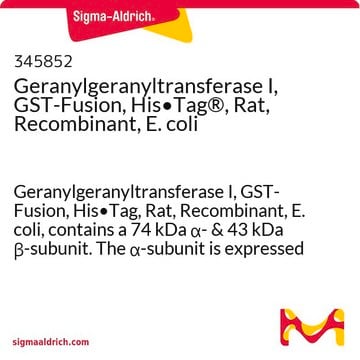Products may be shipped at a different temperature than the recommended long-term storage temperature. If the product quality is sensitive to short-term exposure to conditions other than the recommended long-term storage, it will be shipped on wet or dry-ice. If the product quality is NOT affected by short-term exposure to conditions other than the recommended long-term storage, it will be shipped at ambient temperature. As shipping routes are configured for minimum transit times, shipping at ambient temperature helps control shipping costs for our customers. For more information, please refer to the Storage and Transport Conditions document: https://www.sigmaaldrich.com/deepweb/assets/sigmaaldrich/marketing/global/documents/316/622/storage-transport-conditions-mk.pdf
G6025
Geranylgeranyl pyrophosphate ammonium salt
solution, ≥95% (TLC), ~1 mg/mL in methanol: NH4OH (7:3)
Synonym(s):
GGPP, all trans-3,7,11,15-Tetramethyl-2,6,10,14-hexadecatetraenyl pyrophosphate ammonium salt
About This Item
Recommended Products
Quality Level
Assay
≥95% (TLC)
form
solution
packaging
vial of 200 μg
concentration
~1 mg/mL in methanol: NH4OH (7:3)
storage temp.
−20°C
SMILES string
C\C(C)=C\CC\C(C)=C\CC\C(C)=C\CC\C(C)=C\COP(O)(=O)OP(O)(O)=O
InChI
1S/C20H36O7P2/c1-17(2)9-6-10-18(3)11-7-12-19(4)13-8-14-20(5)15-16-26-29(24,25)27-28(21,22)23/h9,11,13,15H,6-8,10,12,14,16H2,1-5H3,(H,24,25)(H2,21,22,23)/b18-11+,19-13+,20-15+
InChI key
OINNEUNVOZHBOX-QIRCYJPOSA-N
Application
- in the preparation of 2.5X reaction buffer for Rab GGTase assay[1]
- to add to the culture to further drive Hmg2 degradation[2]
- as a substrate to carryout in vitro enzymatic assays for the characterization of the prenyltransferases[3]
- to reverse the action of lovastatin and also used to examine the potential role of GGPP in the study to assess the effects of exposing the melanoma cell lines in the angiogenesis model as a co-culture to lovastatin in vitro[4]
Biochem/physiol Actions
Features and Benefits
Signal Word
Danger
Hazard Statements
Precautionary Statements
Hazard Classifications
Acute Tox. 3 Dermal - Acute Tox. 3 Inhalation - Acute Tox. 3 Oral - Flam. Liq. 2 - STOT SE 1
Target Organs
Eyes
Storage Class Code
3 - Flammable liquids
WGK
WGK 2
Flash Point(F)
51.8 °F - closed cup
Flash Point(C)
11 °C - closed cup
Personal Protective Equipment
Choose from one of the most recent versions:
Certificates of Analysis (COA)
Don't see the Right Version?
If you require a particular version, you can look up a specific certificate by the Lot or Batch number.
Already Own This Product?
Find documentation for the products that you have recently purchased in the Document Library.
Customers Also Viewed
Articles
Cyclic nucleotides like cAMP modulate cell function via PKA activation and ion channels.
Cyclic nucleotides like cAMP modulate cell function via PKA activation and ion channels.
Cyclic nucleotides like cAMP modulate cell function via PKA activation and ion channels.
Cyclic nucleotides like cAMP modulate cell function via PKA activation and ion channels.
-
How is shipping temperature determined? And how is it related to the product storage temperature?
1 answer-
Helpful?
-
-
How can I determine the shelf life / expiration / retest date of this product?
1 answer-
If this product has an expiration or retest date, it will be shown on the Certificate of Analysis (COA, CofA). If there is no retest or expiration date listed on the product's COA, we do not have suitable stability data to determine a shelf life. For these products, the only date on the COA will be the release date; a retest, expiration, or use-by-date will not be displayed.
For all products, we recommend handling per defined conditions as printed in our product literature and website product descriptions. We recommend that products should be routinely inspected by customers to ensure they perform as expected.
For products without retest or expiration dates, our standard warranty of 1 year from the date of shipment is applicable.
For more information, please refer to the Product Dating Information document: https://www.sigmaaldrich.com/deepweb/assets/sigmaaldrich/marketing/global/documents/449/386/product-dating-information-mk.pdfHelpful?
-
-
How can the molarity of Geranylgeranyl pyrophosphate ammonium salt, G6025, be calculated?
1 answer-
The product is a 1 mg/mL (2.5 mM) solution of geranylgeranyl pyrophosphate in a 7:3 mixture of methanol and 10 mM ammonium hydroxide. Additionally, the solution is 2 mM in ammonium bicarbonate. It is important to note that this is a triammonium salt of geranylgeranyl pyrophosphate and has a molecular weight of 501.
Helpful?
-
Active Filters
Our team of scientists has experience in all areas of research including Life Science, Material Science, Chemical Synthesis, Chromatography, Analytical and many others.
Contact Technical Service


















